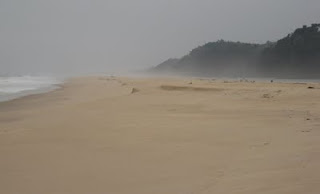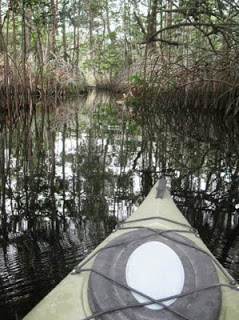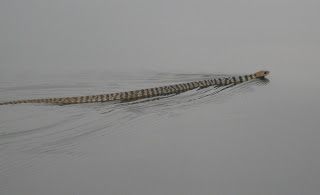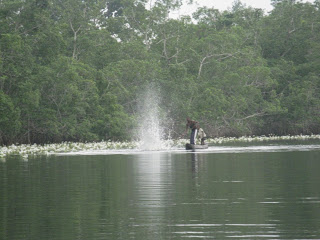Congo: Conkouati Lagoon
I’ve been at Conkouati National Park for 2 weeks now and have boated around most of the southern end of the large lagoon. One of the first days we went out to where the lagoon drains into the Atlantic Ocean. The lagoon is formed from many rivers that meander down from mountains west of here and drain into lakes and then rivers north of the lagoon. Then the lagoon stretches through lowland forest and mangrove channels to the sea. Just before reaching the ocean it jogs north, leaving a thin sandy peninsula between lagoon and beach. In the photo below you can see a sliver of lagoon under the forest on the right side. One of the first days I was here we took a boat to 5 different sandbars spread out around the southern part of the lagoon. People have reported seeing manatees on some of these sandbars in the past, so I wondered if I would find Halodule wrightii seagrass, which is the only species that grows in this part of Africa. I found Halodule near the mouths in several places in Gabon and it’s known to be a favorite food of manatees. However, there was none here. Instead I found lots of tiny clam shells resting on the sand, and when I dug into the sandy mud I found hundreds of live ones just below the surface. As readers of this blog know, I’m trying to document that manatees eat clams and other shellfish in Africa… I hear reports about it most places I work, but it’s hard to prove without samples from manatees (which can be a skin sample, nobody has to die!). In the meantime I’m collecting reference samples of plants and shellfish that manatees supposedly eat, so that I can prove it later, once I’m able to sample manatees.
One of the first days I was here we took a boat to 5 different sandbars spread out around the southern part of the lagoon. People have reported seeing manatees on some of these sandbars in the past, so I wondered if I would find Halodule wrightii seagrass, which is the only species that grows in this part of Africa. I found Halodule near the mouths in several places in Gabon and it’s known to be a favorite food of manatees. However, there was none here. Instead I found lots of tiny clam shells resting on the sand, and when I dug into the sandy mud I found hundreds of live ones just below the surface. As readers of this blog know, I’m trying to document that manatees eat clams and other shellfish in Africa… I hear reports about it most places I work, but it’s hard to prove without samples from manatees (which can be a skin sample, nobody has to die!). In the meantime I’m collecting reference samples of plants and shellfish that manatees supposedly eat, so that I can prove it later, once I’m able to sample manatees. I spent many days paddling around Conkouati Lagoon in a kayak looking for manatees, but despite great habitat and no hunting here, I saw none. There could be several reasons for this: they could be very scarce, they could be very shy, and/or they may only be active at night, which is the case in some places in Africa. It’s an enormous lagoon and fishermen are everywhere, plus it was logistically difficult for me to go out at night.
I spent many days paddling around Conkouati Lagoon in a kayak looking for manatees, but despite great habitat and no hunting here, I saw none. There could be several reasons for this: they could be very scarce, they could be very shy, and/or they may only be active at night, which is the case in some places in Africa. It’s an enormous lagoon and fishermen are everywhere, plus it was logistically difficult for me to go out at night. Kayaking through mangrove tree tunnel.. there are lots of these here.
Kayaking through mangrove tree tunnel.. there are lots of these here. I did see lots of other nice wildlife, including both wild chimps an these semi-wild ones (that were rescued by 2 different organizations here and reintroduced to islands in the lagoon).
I did see lots of other nice wildlife, including both wild chimps an these semi-wild ones (that were rescued by 2 different organizations here and reintroduced to islands in the lagoon). One day hile kayaking I saw something making a wake in the water in the distance. Hoping it was a manatee I paddled madly up to it, only to find it was this snake. It was very pretty, with aqua blue and black stripes…. I don’t know what species it is (does anyone out there know?). It was about 2 feet long and had a brown belly.
One day hile kayaking I saw something making a wake in the water in the distance. Hoping it was a manatee I paddled madly up to it, only to find it was this snake. It was very pretty, with aqua blue and black stripes…. I don’t know what species it is (does anyone out there know?). It was about 2 feet long and had a brown belly.  While paddling and boating around I noticed I constantly heard banging noises from fishing boats. The fishermen use a technique here called “tapez tapez”… they use nets with a very fine mesh, and once the nets are set they bang on the sides of their boats and beat the water to scare all the fish into their nets. Several older fishermen are trying stop this practice because it catches even tiny juvenile fish, thereby depleting the lagoon. The younger men apparently don’t care, they’re looking for fast money. Aside from the important issue of over-fishing, the constant noise (we heard it around the clock, from all sides of the lagoon) scares off wildlife. I would imagine it certainly scares off mantees, who are generally very shy around boats as it is. So I wonder if this is why I didn’t see any. The old fishermen are trying to get everyone to sign an agreement that they will all stop “tapez tapez”, and my friend Hilde, who runs Conkouati National Park is very eager to get it stopped. But in a place where people are so poor, and in a lagoon so large, it’s a huge challenge.
While paddling and boating around I noticed I constantly heard banging noises from fishing boats. The fishermen use a technique here called “tapez tapez”… they use nets with a very fine mesh, and once the nets are set they bang on the sides of their boats and beat the water to scare all the fish into their nets. Several older fishermen are trying stop this practice because it catches even tiny juvenile fish, thereby depleting the lagoon. The younger men apparently don’t care, they’re looking for fast money. Aside from the important issue of over-fishing, the constant noise (we heard it around the clock, from all sides of the lagoon) scares off wildlife. I would imagine it certainly scares off mantees, who are generally very shy around boats as it is. So I wonder if this is why I didn’t see any. The old fishermen are trying to get everyone to sign an agreement that they will all stop “tapez tapez”, and my friend Hilde, who runs Conkouati National Park is very eager to get it stopped. But in a place where people are so poor, and in a lagoon so large, it’s a huge challenge. So the search continued…..
So the search continued…..


Lucy, I'm not sure what species that snake is, but I'm pretty sure I saw one just like it years ago during a trip up the Rembo Ndogo River, NE of Gamba. I was sitting by the river fishing at one point and a snake just like that came swimming up from the depths and then descended back down again, it was a pretty freaky sight.